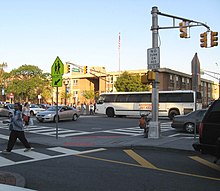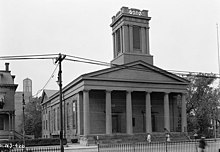Bergen Square
Though there no buildings from the period still standing, the names of streets (such as Vroom, Van Reypen, Newkirk, Tuers, Dekalb) and the grid they form still remain to mark the origins of the earlier village.
[14] Pavonia, the first European settlement on the west bank of the Hudson River, was temporarily evacuated during a series of raids and retaliations between the Dutch and the Lenape, the Native Americans who lived there at the time known as Kieft's War.
Responding to settlers wishes to secure their holdings and wanting to re-establish control of the area, Stuyvesant negotiated a deal in 1658 with the Lenape for the larger area named Bergen, "by the great rock above Wiehacken," then taking in the sweep of land on the peninsula west of the Hudson and east of the Hackensack River extending down to the Kill Van Kull in Bayonne.
In 1664, a negotiated surrender gave control of New Netherland to the English, who on September 22, 1668, recognized and confirmed original town charter.
To celebrate the 250th anniversary of the town's founding in 1910,[19] The New York Times sponsored a seven-week composition competition for Jersey City students to study and write about its history.




